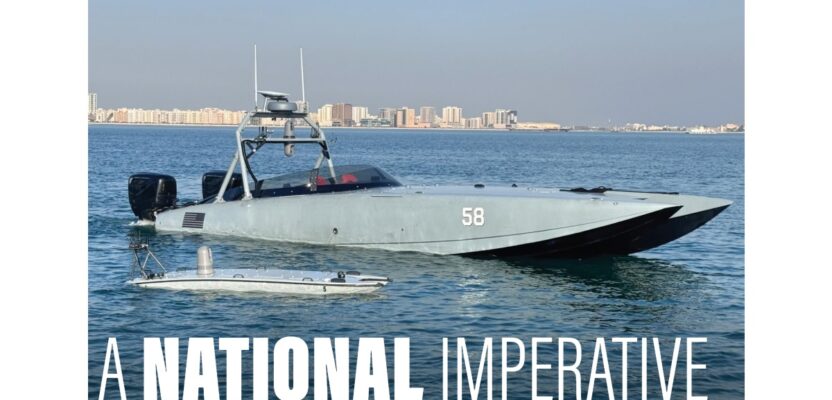Protecting both legacy and green offshore energy sources with new technologies should be a national priority
For the foreseeable future, the world’s economy will depend on energy. This energy comes in two primary types: “legacy” sources such as oil and gas, and “green” energy sources such as solar and wind. Increasingly, nations and energy companies are searching for, and extracting, these legacy energy sources offshore, as well as undertaking new projects to harvest wind energy offshore.
However, regardless of the type of energy being extracted or generated, those platforms that are offshore, especially oil rigs, oil and gas pipelines, and wind farms, are incredibly vulnerable.
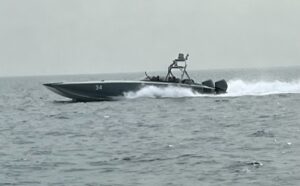 The sabotage of Nord Stream gas pipelines that run from Russia to Europe under the Baltic Sea in September 2022 garnered international headlines for an extended period. Most of the reporting regarding this event focused on speculation regarding who carried out this attack. However, what was lost in the search for a culprit was the vulnerability of these offshore energy sources to attack or other less insidious damage.
The sabotage of Nord Stream gas pipelines that run from Russia to Europe under the Baltic Sea in September 2022 garnered international headlines for an extended period. Most of the reporting regarding this event focused on speculation regarding who carried out this attack. However, what was lost in the search for a culprit was the vulnerability of these offshore energy sources to attack or other less insidious damage.
As the world increases its dependence on offshore energy sources, there has not been a concurrent investment in resources that can be brought to bear to protect these multi-million-dollar platforms. It is increasingly clear that current methods of inspecting offshore energy resources such as oil rigs and offshore wind farms are ineffective.
Given the enormous strides in the use of unmanned maritime vehicles in the past few years, it is long past time for the offshore energy industry to consider adopting these platforms to provide an enhanced level of security.
Legacy Energy Sources Remain in High Demand
The world’s energy needs will continue to be met primarily by oil and natural gas for years to come. Offshore energy production of these legacy energy sources has been increasing over the past decade and now stands at over 2.5 million barrels of oil and almost three trillion cubic feet of gas a day.
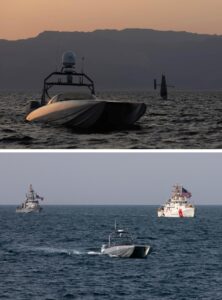 For the United States, this massive production effort is sustained by hundreds of offshore drilling rigs, primarily in the Gulf of Mexico. The U.S. government has made a major commitment to extracting even more energy from beneath the oceans and seas. As one example, the U.S. Department of the Interior has opened 25 regions in the U.S. outer continental shelf to oil and gas exploration.
For the United States, this massive production effort is sustained by hundreds of offshore drilling rigs, primarily in the Gulf of Mexico. The U.S. government has made a major commitment to extracting even more energy from beneath the oceans and seas. As one example, the U.S. Department of the Interior has opened 25 regions in the U.S. outer continental shelf to oil and gas exploration.
While offshore oil and gas companies have been proactive in ensuring the safety of their offshore platforms, more remains to be done. Using current technology, this is dull, dirty, and dangerous work that impedes comprehensive inspections of these production rigs.
Today, platform operators depend on divers and remotely operated vehicles (ROVs) to perform these inspections. This is good as far as it goes, but ROVs have a limited field of view, and putting divers in the water always involves substantial risk and increasingly high cost.
Offshore Wind Farms Are Proliferating at a Rapid Rate
Offshore wind farms have seen explosive growth, and predictions of more wind farms in littoral waters point to exponential growth for this industry. Several offshore wind farms are in operation now, and many more are planned. Offshore wind farms are garnering headlines across the globe for their sheer scale.
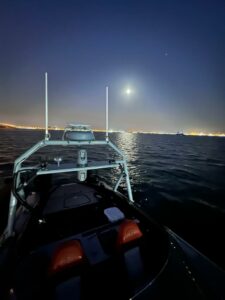 According to the World Economic Forum, global capacity of large-scale wind farms is expected to increase 10-fold, from 34 GW in 2020 to 330 GW in 2030 and spread throughout 24 countries (up from nine today).
According to the World Economic Forum, global capacity of large-scale wind farms is expected to increase 10-fold, from 34 GW in 2020 to 330 GW in 2030 and spread throughout 24 countries (up from nine today).
Indeed, much of the reporting regarding offshore wind farms is focused on one nation besting the other in how it can field larger and larger wind farms faster than others.
To gauge the magnitude of this enthusiasm for offshore wind energy, the World Economic Forum report referenced above predicts that one trillion U.S. dollars will be invested in these energy assets in the next decade. Sadly, there has been little dialogue as to how to protect these expensive offshore wind farms, and they remain highly vulnerable.
A Search for More Effective Protection
Oil and gas companies certainly recognize the need to protect their expensive offshore platforms, but the technology they are using to do so is decades old, expensive, and is inherently dangerous. There is little evidence that, given the newness of their industry, offshore wind farms owners are thinking about how to protect their expensive assets.
Juxtapose this dependence on legacy offshore energy protection systems with the rapid production and use unmanned surface vehicles (USVs) today. These USVs are being fielded in both the military and civilian world and as these assets are put into the hands of operators, new and innovative ways are being generated to perform missions heretofore done by manned systems. One of the most prominent is that of protecting offshore energy sources.
Much of the impetus to use unmanned surface vehicles for these kinds of civilian missions emerged from their use in military exercises, experiments, and demonstrations. Spurred by the need to have USVs perform some of the dull, dirty, and dangerous work previously performed by naval vessels, the U.S. Navy and Marine Corps have evaluated these platforms as candidates to perform a wide array of missions.
After observing these USVs capably perform these military missions over many years, civilian users began to evaluate their use for non-military missions such as port and harbor security, environmental sampling and monitoring, navigation applications, hydrographic surveys, water quality monitoring, and mobile inspections of bridges, dams, oil platforms, and pipelines among others. While these missions are important, it is the last one that is most urgent.
One Best-Practices Example
While there are any number of capable and affordable unmanned surface vehicles either currently in the field or in various stages of design or production, I will focus on one platform that is a commercial-off-the-shelf system that has been in use for almost a decade and that has been “wrung out” in a wide-variety of military and civilian events.
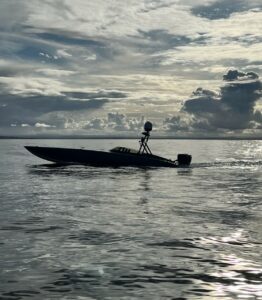 Maritime Tactical Systems, Inc. (MARTAC), a Florida-based manufacturer of unmanned surface vehicles, has fielded a family of low-cost, rugged and adaptable MANTAS T12 and Devil Ray T24 and T38 unmanned surface vehicles. Part of the attraction of using these USVs to inspect offshore oil and gas platforms, pipelines, and offshore wind farms is that these unmanned surface vehicles have seen extensive use in military exercises, experiments, and demonstrations, as well as hundreds of hours of use in a number of civilian missions ranging from commercial canal and dam hydrography, to commercial power plant inspections, to port and harbor security.
Maritime Tactical Systems, Inc. (MARTAC), a Florida-based manufacturer of unmanned surface vehicles, has fielded a family of low-cost, rugged and adaptable MANTAS T12 and Devil Ray T24 and T38 unmanned surface vehicles. Part of the attraction of using these USVs to inspect offshore oil and gas platforms, pipelines, and offshore wind farms is that these unmanned surface vehicles have seen extensive use in military exercises, experiments, and demonstrations, as well as hundreds of hours of use in a number of civilian missions ranging from commercial canal and dam hydrography, to commercial power plant inspections, to port and harbor security.
Off-the-shelf technology like this can be used to effect faster and more complete inspections of offshore oil and gas platforms, along with their surrounding bottom mounted pipelines, as well as offshore wind farms, while dramatically decreasing the need for human divers. Three primary missions where those responsible for oil rigs, pipelines, or offshore wind farms would utilize this USV technology include:
- For surface investigation, the Devil Ray, which is already equipped with a Furuno DRS4D-NXT Doppler Radar and AIS, could also carry a SeaFLIR 280-HDEP Multi-Spectral Surveillance System.
- For underwater imaging, the Devil Ray can be equipped with Norbit iWBMS STX multi-beam sonar, a forward-looking or side-scan sonar, or any of many other commercial-off-the-shelf underwater sensors.
- Since one of the early indicators of material failure of oil rig components involves oil and other material from the rig seeping into the surrounding water, the Devil Ray can be equipped with water-monitoring sensors to include Acoustic Doppler Current Profilers (ADCP), Current-Temperature Depth (CTD) sensors, flourometers, and other systems to detect changes in the water quality.
In each of the above missions, a controller would have real-time camera, sonar and/or water quality visibility of the observations being made by the USV. While there are many ways to employ these USVs to protect offshore energy sources, one initial use would be for an operator to have a Devil Ray on patrol on a predictable pattern inspecting the asset above and below water.
If the USV discovers an anomaly and links the video back in real-time, the operator will be alerted and can command the Devil Ray to linger in a particular area for more granular analysis. If this investigation uncovers an area of concern, then a diver can be deployed to make a repair.
Leveraging USVs to Provide Security Offshore
The same USV technology that is poised to assist the oil and gas and offshore wind farm industries is already being used to inspect critical infrastructure such as harbors, ports, inland waterways, dams, levees, canals, bridges, and other infrastructure that cannot be safely or effectively inspected by humans.
For example, a MANTAS T12 was used to conduct inspections of the Keokuk dam and energy center, the Bagnell energy center, the Elkhart hydro dam, the Central Arizona Project canal, and other infrastructure.
The enormous investment that energy companies have made—and will continue to make—in offshore oil and gas rigs and offshore wind farms is one that these businesses must protect against failure, sabotage, or other hazards. Current means of inspecting these rigs are slow, costly, and hazardous. Employing commercial-off-the-shelf USVs can enhance the ability to safely and effectively deliver energy to the world.

